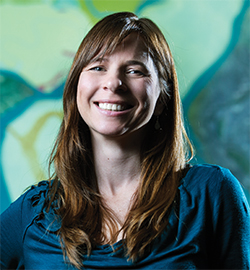Anna Linhoss: Ensuring a pearly future for oyster ecosystems
July 15, 2016
 As a little girl, Anna Linhoss would venture out to Mobjack Bay, about a quarter mile from her home on the Chesapeake Bay, where she would collect oysters the size of a shoe.
As a little girl, Anna Linhoss would venture out to Mobjack Bay, about a quarter mile from her home on the Chesapeake Bay, where she would collect oysters the size of a shoe.
Linhoss said there was a time when these oysters completely disappeared from the coast due to disease and contamination from fertilizers. Over time, scientists and researchers worked to help the oyster population return to the area.
“I was interested in science ever since I was really little, but some of my fondest memories as a girl were things like going out in the mud and the marsh and going on field trips out to saltwater areas,” Linhoss recalled.
Now, as an agricultural and biological engineering professor, Linhoss has the opportunity to help oysters by offering her expertise to an integrated ecosystem assessment for the Gulf of Mexico funded by the National Oceanic Atmospheric Administration (NOAA).
Linhoss is working with a hydrodynamic model, which simulates water flows and resulting salinities from rivers and the ocean. Oysters reside in estuarine waters, the place where freshwater and ocean water meet. She said this hydrodynamic model simulates these estuaries and allow researchers to create and study scenarios that could impact the oyster population.
This development will help set the stage for a water quality model, which simulates how oysters will respond to the nutrients and dissolved oxygen in the water. Linhoss said that the right amount of these elements are needed to ensure the perfect breeding environment for oysters.
One of the objectives of this project is to use oysters as an indicator species for the Gulf, meaning the researchers will use oyster survivability under different conditions as an indication of the overall health of the Gulf of Mexico.
Linhoss said water resources are a vital issue because of the growth of development, industry, climate variability and the number of increasing residents on the coast. She said that engineering is able to offer some solutions in these areas.
“Engineering is a discipline that can investigate how to share, use and conserve water resources through modeling,” Linhoss said. “Engineering is a very good way to approach the water resources problem, because we are generally problem solvers.”
Linhoss explained that oysters are a huge economic resource for the Gulf Coast and that by understanding how land use decisions will affect oyster populations, experts can better manage natural resources to benefit the land, water and people who depend on both of those for a living.
“There are a lot of fishermen that depend on oysters for their jobs, and the larger coast depends on that oyster industry as well,” Linhoss said. “If we can maximize oyster harvests, that’s really going to benefit the coast.”
Linhoss stressed that not only are there economic incentives, but an opportunity to maximize the overall health of the coast, which helps other fisheries that depend on the coast. She said the coast’s tourism, natural aesthetic and value as a natural resource are all reasons that make this research even more valuable. Having grown up on a coastline, Linhoss understands the significance oysters can have on a community.
“I’ve seen this impact first hand, and that’s a big reason why I’m interested in this project,” Linhoss said. “Estuarine areas and oysters are very close to my heart.”
For more information about the Bagley College of Engineering, visit bagley.msstate.edu.
For more articles from Dimensions, the BCoE’s 2016 Annual Report, visit https://issuu.com/bcoe/docs/dimensions2016.
By: Jen Nguyen
